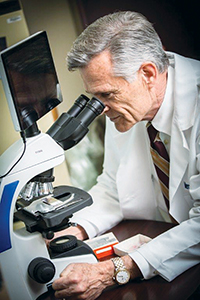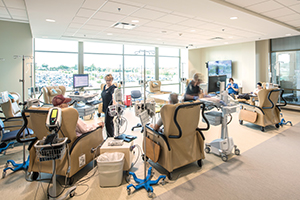By COLLEEN SCHRAPPEN
Determining a woman's risk of developing breast cancer is complicated. Heredity, genetics and lifestyle all can factor in. So too can anatomy.
Women who have dense breasts, meaning they have a higher percentage of non-fatty and glandular tissue in their breasts, are also considered to be at some increased risk of breast cancer, though many are unaware of this correlation.

Dr. Alan Hollingsworth
In November, Oklahoma will join 26 other states that require women who have undergone mammograms to be notified if they are found to have dense breast tissue. Each state determines its own parameters for which women to include in that category and how they will be told. Some states require all women to be notified about potential diagnostic challenges and cancer risk for women with dense breasts; others require notification for women who fall in the top percentiles for tissue density.
Dense breast tissue is not abnormal. Are You Dense Advocacy, a nonprofit that is promoting the legislation at the state and federal level, says that 40 percent of women have dense breast tissue. In Oklahoma, women in the top 50th percentile of breast density will receive a letter from their mammogram provider that states, in part, "dense breast tissue may make it more difficult to detect breast cancer and may be associated with an increased risk of breast cancer." The letter advises women to talk to their health care provider to determine if additional screening with more sensitive tests is warranted.
Tail of the bell curve
It's a notification that Dr. Alan Hollings-worth has pushed for, and he did so long before the legislative initiative in Oklahoma. He directs the Mercy Breast Health Center, which is located in the new Coletta Building at Mercy Hospital Oklahoma City. In Hollingsworth's opinion the Oklahoma law leaves a lot to be desired in part because it casts the net so widely with its notification requirements. Too, the law doesn't require insurers to pay for the advanced screens for women who receive notifications — including the 10 percent of women with the densest breast tissue whom Hollingsworth says could most benefit from advanced screening technology.
Hollingsworth says a plot graph of breast tissue density would fall along a bell curve. Risk slowly rises along with breast density. About 10 percent of the population fall on the tail denoting extreme breast density. Those women are the ones who would benefit the most from additional screening, he says, as would women with increased risk due to factors such as family history, prior biopsies that showed precancerous conditions and genetic markers associated with increased cancer risk.
At the Mercy Breast Health Center Hollingsworth and a medical geneticist, Dr. Marsha Pratt, perform risk assessments, including family medical histories, genetic testing and long-term high-risk screening using both breast MRI and whole breast ultrasound — both as adjuncts to annual mammography.
Lighting up cancer
Hollingsworth was practicing as a breast surgeon when, in 2003, he developed a breast density scoring system coupled to risk levels for Mercy patients as a guide to select patients for breast MRI, in which the injectable dye "makes cancer light up." He estimates that breast cancer may not have been diagnosed in as many as half of his patients with extremely dense breasts or other elevated risks had clinicians relied solely on mammography results.
In 2007, the American Cancer Society issued landmark guidelines for breast screening with MRI, preempting Hollingsworth's published scoring system. However, those guidelines did not take a stand on how to incorporate breast density into the selection process, Hollingsworth said. Mercy's ability to perform automated whole breast ultrasound, a relatively new test, in women with dense tissue, solves that problem for women who aren't candidates for an MRI, he says.
Lost in the background
Dense breasts are a "double jeopardy," Hollingsworth says. In addition to the modest increase in cancer risk, mammograms — the standard in breast screenings — are significantly less effective at detecting cancer in women with dense breasts. Women with extremely dense breast tissue have a fourfold increased cancer risk compared to women with extremely low breast density, he says, although this is a comparison of the extremes. "When compared to the average woman, extreme density, called Level D, imparts a twofold increased risk — roughly the same as your mother having breast cancer.
"The fibroglandular tissue in breasts is white on a mammogram. Cancer also shows up white," says Hollingsworth. "So it gets lost." For women with the densest breasts, mammograms miss cancer at least half the time, Hollingsworth says. For women at the other end of the bell curve, whose fatty breast tissue shows as black on a mammogram, the miss rate is just 5 percent.
Mercy Breast Health Center at the Coletta Building is the first in Oklahoma City to have an automated whole breast ultrasound machine. The machine takes a picture of the entire breast, allowing radiologists to pick up cancer that might otherwise go undetected. Breast ultrasound, fortunately, is at its best in dense breast tissue, says Hollingsworth. The camouflage effect is gone. Because of its acoustic properties, cancer appears as a gray "hypodense" mass in a white background. False-positives with ultrasound are higher in the fatty breast, lower in the dense breast. So, mammography and ultrasound are nicely complementary, given that mammography works very well in the low density breast, Hollingsworth says.
Out-of-pocket
For patients with dense breasts but no additional risk factors, Hollingsworth recommends the ultrasound. For women who have additional risk factors, he prefers a breast-dedicated MRI scan.
But some women fall short of qualifying for insurance coverage for the MRI even though they are at an elevated risk, Hollingsworth says. He adds that the Mercy Breast Health Center will offer both the MRI and whole breast screening ultrasound at a discount when a patient pays at the time of service: $750 plus the professional charge by the radiologist for the MRI, and $295 total for the ultrasound.
About 10,000 to 12,000 women are screened at Mercy Oklahoma City's facilities each year. Hollingsworth estimates about two in 10 have enough risk factors to recommend supplemental screening, though only half of that group will qualify for breast MRI.
Under the Oklahoma law, approximately one half of the patients receiving screening mammograms will require notification that they have dense breasts. Hollingsworth says a radiologist technician at Coletta will give those individuals a brochure that explains screening options for women with dense breasts. The patients will receive the notice required by the state through the mail. In the near future, the breast center would like to have a nurse practitioner sit down with each patient identified as having dense breast tissue and explain the implications of the condition to allay concern while raising awareness.
| Mercy has enlisted patients in designing cancer center Jim Gebhart, president of Mercy Hospital Oklahoma City, says Mercy is on track to provide outpatient cancer services for up to 30,000 patients on its campus this year, up from 25,000 patients the prior year. It will do so in its newly opened cancer center, housed in the $80 million Coletta Building, which opened in June.  Patients receive chemotherapy infusions at the new Mercy Cancer Center at Mercy Hospital Oklahoma City. "Unfortunately, cancer continues to be a growing health concern for Oklahoma," he says. Mercy facilities and physician providers have grown in response to demand for cancer care, and we found ourselves wanting to improve the level of service, to bring services together in one building." Mercy took an inclusive approach to designing programs and physical space for its center, soliciting input from administrators, physicians, other staff, patients and their families. Discussions on layout and amenities began more than three years ago. "It's the little things that matter," says Courtney Marquez. A brand experience manager at Mercy, she held monthly meetings with patients, family members and Mercy staff to mine their ideas. Marquez found people value having control over their environment including temperature, noise level and light. The chemotherapy infusion space gives patients the option for solitude or to interact in a group setting, "a private-to-public approach, depending on how you're feeling," she says. There's space for caregivers to have lunch with patients during their infusion and a healing garden just outside the door. The advisory group's input can be seen in the prominent placement of the chapel near the building's main entrance, in the abundant natural light and in the greenery, which makes the space more welcoming. At Coletta, patients also have access to massage, music and art therapy, and classes to help them transition back to their posttreatment lives. "It's intuitive to us that if you feel better, you're more likely to do better," says Gebhart. "One of the most dramatic things a patient will go through is cancer treatment. Making it easier is a tremendous win." The Coletta Building is named for the late Sr. Mary Coletta Massoth, RSM, an administrator who, in the mid-1970s, directed Mercy's move from the central city to a 40-acre campus built on pasture land in an area that would become a center for population growth. — COLLEEN SCHRAPPEN |
Copyright © 2016 by the Catholic Health Association
of the United States
For reprint permission, contact Betty Crosby or call (314) 253-3477.